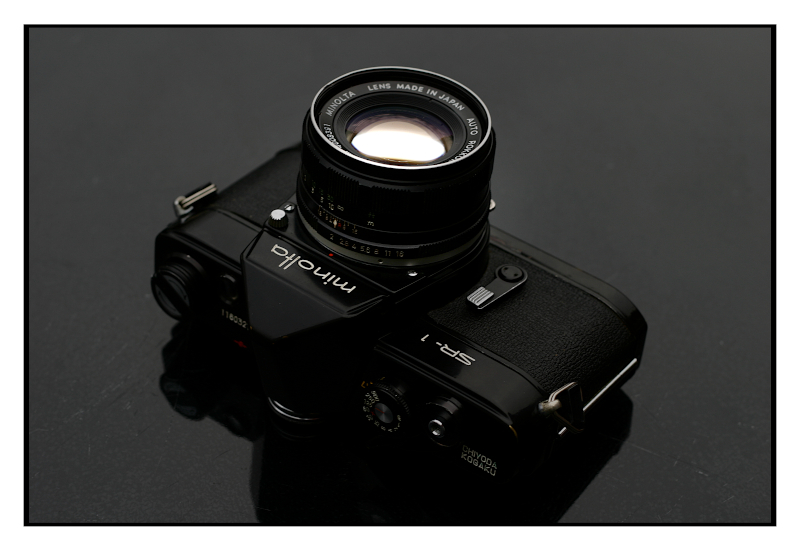Jason Schneider
the Camera Collector
The Most Beautiful Cameras of All Time, Part 2
Manual focus 35mm film SLRs of the ‘50s through the ‘80s
By Jason Schneider
With the caveat that beauty is ever inthe eye of the beholder and that one person’s swan may be another’s vulture, here are my 10 personal picks as the most beautiful SLRs of the analog era. The fact that most of them happen to be very good cameras may or may not be coincidental, for as someone once said, “beauty is as beauty does.” Anyway, please remember that this is all done in a spirit of fun and that since beauty is inherently subjective, your choices may well be as valid as mine.
Nikon F: When Nikon unveiled the Nikon F, its first 35mm SLR, in 1959, it created a worldwide sensation, and soon established itself as the top selling 35mm camera among working pros. It was an audacious move on Nikon’s part, but they realized that their glorious Nikon SP was a technological dead end,and that the future was in 35mm SLRs. Indeed, Nikon discontinued their entire rangefinder line only one year later in1960, though they did bring out commemorative special editions from time to time. The Nikon F is essentially a Nikon S-series rangefinder body with an integrated mirror box added. A ruggedworkhorse professional SLR, its interchangeable meter prism meant it could be upgraded as metering technology advanced. However, when a Nikon F is fitted with one those chunky, clunky meter prisms it becomes a bit of a klutz. Fit the camera with a plain (non-metered) Nikon F prism and a wide-angle or normal prime lens and its spare, perfectly proportioned, angular beautyshinesthrough. Indeed, the Nikon F in black with a plain prism is one of the most beautiful 35mm SLRs ever made. Even the handsome Nikon F2 and F3, which are functionally superior, can’t hold a candle to the basic bare bones Nikon F in sheer physical beauty.
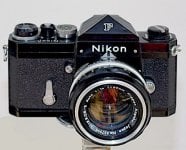
The Nikon F in black with plain non-metered F prism and 50mm f/1,4 Nikkor-S lens is a perfectly proportioned, understated masterpiece of concise design.
Canon F-1: Introduced in the summer 1970 as a successor to mighty but ill-starred Canonflex of 1959,the ruggedly beautiful Canon F-1 was Canon’s first professional SLR to successfully go up against the Nikon F and garner a significant share of the pro SLR market. Supported by a humongous array of system accessories, and an extensive line of Canon FD lenses, that fully communicate with the camera, the F-Ihas a horizontal titanium foil shutter with speeds of 1-1/2000 sec plus B, a TTL metering using a CdS cell located on the side of the focusing screen thatworks independently of the attached finder, and a slide-on finder prism allowing focusing screens to be easily lifted out. An accessory Servo EE finder provides shutter priority automatic exposure using an arm attached to the left-hand side of the finder to operate the lens diaphragm.The Canon F-1 and the F-1n (its nearly identical,lightly upgraded stablemate introduced in 1976) are great user cameras even today, providing they’re modified to accept modern 1.5v silver oxide or alkaline button cells instead of the original 1.35v mercury cells. The Canon F-1’s crisp, angular, exquisitely proportioned form factor has that indestructible “muscular” look reminiscent of (dare we say it?) the Nikon F, but it’s distinctive enough that nobody would mistake it for its archrival. Anyway, I think it’s gorgeous in a way that its attractive, significantly improved successor, the Canon F-1 NEW of 1981, is not.
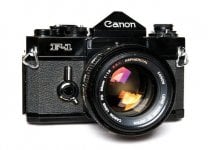
Canon F-1 original model with 50mm f/1,2 Canon S.S.C Aspherical FD lens: Exquisitely proportioned and assertive, it exudes power and class.
Exakta VX IIa: The Exakta VX IIa of 1956-1960 is the lineal descendent of the original landmark Exakta I of 1936, the first widely successful 35mm SLR in the world (and second only to the ugly but competent Russian-made Sport of c. 1935, a 35mm SLR distributed in limited quantities, mostly in the USSR). Like its predecessors, the Exakta VX IIa features a trapezoidal shaped body, a very long throw left-handed wind lever, a horizontal cloth focal plane shutter with speeds to 1/1000 sec, a front mounted shutter release (which facilitated the use of external auto diaphragm lenses), anold-fashioned rotating lift-and set fast shutter speed dial, and slow shutter speeds actuated by winding a spring-loadedknob! By the time the VX IIa rolled around they hadadded interchangeable finders and built-in flash sync. Vintage Exaktas are idiosyncratic, clunky, and slow— an acquired taste for sure. But they do have that breathless look of “fine machinery,” resembling scientific instruments with their profusion of cool looking dials, knobs, and widgets. Indeed, Exaktas were embraced by scientists who required parallax free viewing for photo-microscopy, astro-photography, and everything in between, becoming the first de facto 35mm SLR system thanks to a stupendousarray io accessories, and lenses by top makers including Zeiss, Schneider, Meyer, Enna, Steinheil, etc. Most Exataphiles agree that the prettiest VX IIa is listed in Wrotniak’s excellent Exakta Taxonomy as model *5.1.3 of 1958-1960, with serial numbers ranging from 850000 to 890000. Why? The Exakta name is embossed in shiny relief on the front plate rather than being engraved as before, lending a touch of class to this unabashedly function-forward design.
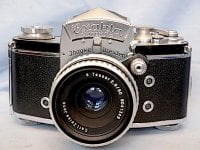
Exakta VX IIa with classy embossed nameplate has the look of precision machinery. Lenses like this 50mm f/2.8 Zeiss Tessar gave it performance to match.
Zunow Reflex: This limited production 1958 masterpiece was made by Zunow Optical Industry, a Japanese company renowned for its super-speed lenses such as the 50mm f/1.1 Zunow, then the fastest normal lens in Nikon S bayonet and Leica screw mount. When they decided to get into camera manufacturing, they went all out, creating a remarkably compact and elegant design said to be inspired by the Contax S (the first pentaprism SLR) the Praktina, and the Miranda T. It incorporated what was then cutting-edge tech, including a 180° single-stroke wind lever, an internally coupled automatic lens diaphragm, a bright 100% pentaprism viewfinder, and an instant-return mirror, which they called the “Wink Mirror System.” Other features includeinterchangeable finders and focusing screens, shutter speeds of 1-1/1000 sec plus B on a single non-rotating shutter speed dial around the film advance axis, a square front-mounted, right-handed shutter release, a self-resetting frame counter with a red flag indicating that the shutter has been fired but not re-cocked, and adapters allowing the use of Exakta, Practica/Pentax, and Leica lenses. The standard lens was a 5cm f/1.8 Zunow and there was a rare 5.8cm f/1.2 Zunow, probably the fastest normal lens for any SLR at the time. Other Zunow lenses include a35mm f/2.8, 100mmm f/2, 200mm f/4, 400mm f/5.6, and an 800mm f/8. Visually stunning and exquisitely proportioned, some say the Zunow inspired the Nikon F that came out a year later in 1959. Sadly, the company was only able to turn out 8 of these gems per day at the maximum production rate, and Zunow went belly up a few years later.Today the beautiful Zunow is fetchingly rare and the lenses are even rarer, A clean 1959 3-lens Zunow outfit with original box and a few accessories is expected to fetch 80-90k Euros at auction.
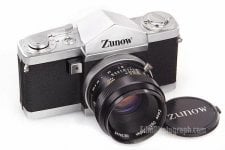
Zunow Reflex of 1958 was way ahead if its time in terms of features, and beautiful besides, but it ran into production problems and it's now rare and pricey.
Asahi Pentax H2:The Asahi Pentax H2 (aka the S2) was released in 1959, a year after the Asahi Pentax K, the company’s first pentaprism SLR and the first to use the M42 Praktica/Pentax screw mount (up from 37mm on the earlier Asahiflexes).The H2's top shutter speed was reduced from the K's 1/1000s to 1/500s, but the camera featured severalimportant upgrades. It was the first Pentax to use a single non-rotating shutter speed dial, it had a brighter Fresnel focusing screen, and a small window on the top plate that turned red when the shutter was cocked, a standard Pentax feature even on later K-mount modelsThe Pentax H3 introduced at photokina 1960 features a 1/1000 sec top shutter speed and a faster 55mm f/1.8 Auto-Takumar lens. The Asahi Pentax SV (aka H3v) added a built-in mechanical self-timer and was the first Pentax to provide fully automatic aperture operations (previous semi-automatic models required you to push a spring-loaded tab to reset the lens to maximum aperture after each exposure. All these members of what Pentaxians refer to as the “S-family” of Pentax screw-mount cameras released prior to the landmark Pentax Spotmatic of 1964 are exquisitely proportioned, superbly balanced cameras, with gorgeously contoured wind levers and any of them, including the H2, are among the most beautiful SLRs ever made. They’re also great user collectibles, and you can snag a clean working Asahi Pentax H2 with semi-auto 55mm f/2 Takumar lens for around $150.
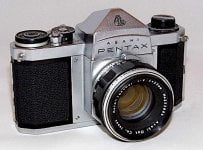
Asahi Pentax H2 with 55mm f/2 Auto-Takumar semi-auto-diaphragm lens: It's clean crisp lines and straightforward balanced proportions make it a classic.
Olympus Pen FT: The second iteration of Yoshihisa Maitani’s brilliant half-frame 35mm SLR, the Pen FT of 1966-1972 added a built-in uncoupled, transfer-the-settingmeter, a self-timer with a cool lollipop-shaped, lever and deleted the gothic F logo on the Pen F, which emphasizesits exceptionally clean, sleek, minimalist design. All Pen Fs including the FT, eliminate the traditional pentaprism hump found on eyelevel viewing SLRs by replacing the solid glass pentaprism with a system or mirrors, including a primary unit that moves out of the light path as the shutter fires. They also employa rotary focal plane shutter with speeds of 1-1/500 sec plus B that provides X sync at all speeds. The FThas a single-stroke wind lever andretains the Pen F’s elegant squarish shutter release on top. However, the TTL CdS metering system steals some light coming through the lens, resulting in a dimmer finder image, ISO settings top out at a blistering 400, and the camera was designed for 1.35v mercury cells and must be adapted to work with current 1.5v silver-oxide or alkaline batteries. If you want an FT-style camera with brighter finder and are willing to forego the built-in meter, go for the Olympus Pen FV of 1967-1970, which is basically a Pen FT minus the meter. Bottom line: the Pen FT and its stablemate the FV are among the most elegantly proportioned, beautifully contoured SLRs ever made and the fact that they’re about the same size as a screw-mount Barnack Leica only emphasizes their appeal as precious objects. They look great in chrome and positively exquisite in black when fitted with a 42mm f/1.2, 40mm f/1.4, or 38mm f/1.8 Zuiko lens. The ultimate Pen FT/FV collector’s prize: a black one fitted with the rare 38mm f/2.8 Zuiko “pancake” lens, the smallest combo possible. You can snag a clean black FT with normal; lens for about 250 bucks, but that pancake lens will set you back about $600, if you can even find one.
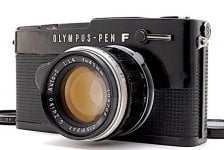
Olympus Pen FT in black with 40mm f/1,4 G. Zuiko Auto-S lens is an elegantly simple classic half-frame SLR and a tribute to master designer Y Maitani.
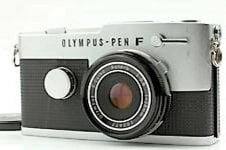
Olympus Pen FT in chrome with "pancake" 38mm f/2.8 Zuiko is about the same size as a Barnack Leica with a retracted 50mm f/3.5 Elmar. It's elegant!
Minolta XD 11: A member in good standing of the ultra-compact SLR revolution inspired by the Olympus OM-1 of 1972, the beautifully proportioned, elegant, minimalist Minolta XD 11 introduced in 1977 was the first SLR to combine aperture priority, shutter priority, and manual metering via LED readouts in the finder, stepless exposure control, and a newly developed Acu-Matte screen for brighter viewing and more decisive manual focusing. Minolta’s last SLR aimed at pros and serious enthusiasts the XD 11 features TTL center-weighted metering using a silicon photocell (SPD) controlled by special low voltage computer circuitry, provides manual mechanical speeds of 1/100 sec plus B, ISO settings from 12-3200, an electromagnetic soft-touch shutter release, and a vertical metal-bladed focal plane shutter with speeds of 1-1.1000 plus B. Its fixed pentaprism viewfinder shows 94% of the 24 x 36mm frame at 0.87x magnification and displays mode, f/stop with MD lenses, and over/under exposure warnings. In addition to having clean understated lines and classic good looks, the XD 11 is an excellent shooter’s camera that operates with consummate smoothness and quietness, and it takes readily available 1.5v silver-oxide batteries. Downsides: its advanced metering circuitry is delicate and if it packs up spares are no longer available, and repairs are costly when possible. Also, its wonderfully soft, cushy leatherlike covering tends to shrink and it doesn’t always look so hot when it’s reglued. The current price for one of these beauties in pristine shape with 50mm f/1.7 or f/1.4 MD or Rokkor-X lens, $100-$200 in chrome, $350 in mint condition in black (body only). Yes, it does look better in black!
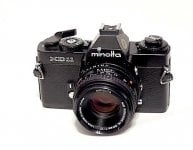
Minolta XD 11: Minolta's technically advanced, compact SLR was its last of the breed aimed at serious shooters, and the most beautiful SLR they ever made.
Olympus OM-1: Designed under the guidance of the late, great Yoshihisa Maitani, the camera engineering genius who created the original pocket-sized Olympus Pen scale focusiing half-frame 35 of 1959 and theingenious Pen F and Pen FT half-frame SLRs, the OM-1 was the smallest lightest full-frame ever made when it debuted in 1972. Indeed, Its body measures only 5-3/8 x 3-1/4 x 2.0 inches (W x H x D) and it weighs in at a mere 18 ounces. Adding a compact 50mm f/1.8 F. Zuiko lens increses its its depth to 3-3/16 inches and its weight by 6 ounces.Improvements including winder compastibility are found in the subsequent OM-1n and OM-1 MD, both of which look identical to the original version except for their clearly visible labels
The jewel-like OM-1 is handsome,crisply styled, beautiflly proportioned, and elegantly understated. It’s also a robust, beautifully made,TTL metering, match-needle camera that feature a cloth focal-plane shutter with speeds from 1-1/1000 sec plus B set “Nikkormat style” via a ring around the lens, a two-CdS cell metering system, a fixed pentaprism with viewing screens interchangeable via the open lens mount, a single-stroke wind lever, a mirror lock-up, and (after the very first iteration) motor/winder compatibility. Standard lensesin OM bayonet mount are a 50mm f/1.4 G. Zuiko or 50mm f/1.8 F. Zuiko, and an extensive system of lenses (8mm to 1000mm), winders, motors, flashes, and accessories were available.
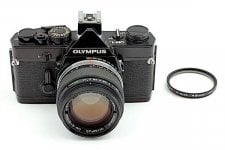
Olympus OM-1n in black with 50mm f/1.4 G. Zuiko Auto-S: exquisitely balanced and tastefully understated this ultra-compact SLR is a timeless classic.
One downside of the OM-1 is its CdS metering syatem that’s subject to the dreaded “memory effect” and takes time to recover once exposed to high ambient light levels. The solution: opt for an Olympus OM-2 or OM-2n,both of which which have the visceral charm and beauty of the OM-1, but use more sensitive,memory freeSBC meter cells, take 1.5v batteries, and provide aperture priority AE as well as manual match-needle metering. Later models like the OM-3 and OM-4 are pretty too, but lack the elemental charm of the OM-1 and OM-2. The biggest problem with the OM3/OM4’s to OM1 & OM2 fans is the loss of elegant design and and a crowded hard to see LED finder readout. An original OM-1MD , OM-1n, OM-2 or Om-2n with 50mm f/1.8 or f/1.4 lensin pristine shape currently fetches about $150-$200 in chrome and about $100 more in black finish, which is worth it becausec showcases these cameras’ clean classic lines.
Nikon FM2 and FM2n: Popular amiong serious photo enthisasts and pros the Nikon FM2 was widely acclaimed for its rugged simplicity, excellent reliabiity, and beatiful classic form factor, and it enjoyed a long production from 1982 to 2001. The original FN2 was released with some incremental improvements (such as a higher flash-sync speed) in 1984, and this later version is oftewn referred to as the FM2n (for the N preceding itsc serial number), although both versions are clearly labelled as the FM2 on the front of the camera body. It was the first Nikon to employ an advanced Nikon-designed, metal-bladed, bearing-mounted, vertical-travel focal plane shutter with a then unprecedented speed range of 1 to 1/4000th second plus B and provided X-sync atan impressive 1/250th sec all without battery power.The FM2 like other classic Nikon compact SLRs including the original FM of 1977, the FE of 1978, the FE2 and FA of 1983, andthe limited production Nikon FM3A of 2001, was built on a copper-aluminium-silicon (copper-silumin) alloy chassis, and although the design of the housing differs from model to model they are all beautiful cameras that exude the same elegant simplicity. The compact Nikon FM/FE family is among the most popular and commercially successful in Nikon’s history.
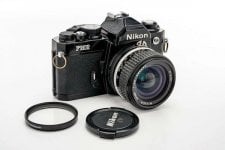
Nikon FM2n looks gorgeous in black with compact 28mm f/2.8 Nikon lens, a combo that showcases its clean, simple, well balanced lines.l
The FM2 is a mechanically controlled manual focus SLR with manual exposure control and only needs the two S76 or A76 batteries, or one 1/3N battery to power the light meter, which employs an internal 60/40 percent center-weighted system linked to a center-the-LED exposure control system. The exposure control system used vertically arranged +/o/– LEDs) on the right side of the viewfinder to indicate the readings of the meter versus actual camera settings.The FM2 is compact, and a pleasure to hold and shoot with, but it’s not quite as petite as an Olympus OM-1 or a Pentax MX, measuring 90mm x 142mm x 60mm (H x W x D) and weighing in at 540g (body only), and it was available inn 2 colors, blasck with chrome trim (very nice) and all black (absolutely gorgeous).In 1993, a special ultra-durable version of the FM2n, the FM2/T was released and sold in parallel with the regular FM2n. The "T" stood for titanium, the material used for the top and bottom plates and the camera back. The Nikon FM2/T listed ata whopping $1,120 and was discontinued in 1997. These days, a clean Nikon FM2 bidy in chrome or black goes for about $200-$300—higher for mint examples in black. A Niokon FM2/T will set you back about $500-600, body only.
Canon T90: Canon’s last pro level manual focus camera, the Canon T90, introduced in 1986, was also the last professional Canon to use rge Canoin FD mount lenses, but it pioneered many of the concepts found in later AF Canon EOS analog and digital cameras includiong a high level of automatioon and metering options, motorized operation, ergononic user interface and its muscular curvilinear “indistrial” form factor that has a somple rugged beauty all its own. Integrated ionto its distinctive “bio-engineered form” was large perfectly contoured handgrip, a top-mopunted full info LCD, a right index finger control wheel placed conveniently behind the shutter release for adjustiong most camera settings in conjunction with buttons for the right thumb, and on the left-hand side if the body. This arrangement was still used on furure Canoin digutal SLRs. Other T90 features include: a fixed eyelevel pentaprism with 94% coverage, interchangeabkle focusing screens, comprehensive viewfinderr information using a 7-segment digital LED display, TTL metering with 3 meter patters using and SPC cell, multiple exposure modes including Program Shift and Flash AE, a vertical travel , electronically controlled metal focal plane shutter with speeds og 30-1.4000 sec plus B and X sunc at 1/250 sec, auto film loading, wind, and rewind with a 4.5 fps burst rate in H mode, a dedicated hot shoe , and TTL autoflash in A-TTL flash mode. The T90 is powered by 4 AA alkaline-manganese or Ni-Cd batteries. The body only measures 153.1 x 121 x 69.4mm, ( W x H x D) and weight in at a hefty 800g.
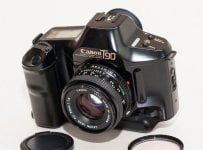
Canon T90: Canon's "everything but autofocus" ultra-tech classic created a new form follows function esthetic for the AF and DSLRs that succeeded it.
A masterpiece of sleek form follows function design that set a new standard for muscular cyrvaceous industrial beauty, the Canion T90 delivers a formidable level of on-film performance and is a superb user camera for today’s intrepid film shooters. A clean fully functional Canon T90 fetches about $125-250 on the current used market, a bargain in terms of sheer performance per dollar.
A GREAT often forgotten feature of the Canon FD and Canon EOS film camera series is their ability to mount more infinity focused lens adapters than any other full frame film SLRs. Canon made Nikon to FD, M42 to FD, Exakta to FD film adapters. Of course many other adapters were made by independent adapter makers. The funny thing about the T90 is that with the Nikon F to FD adapter, its aguably offers a better metering system than any Nikon made Nikon F mount film SLR! Believe it or don’t.
Manual focus 35mm film SLRs of the ‘50s through the ‘80s
By Jason Schneider
With the caveat that beauty is ever inthe eye of the beholder and that one person’s swan may be another’s vulture, here are my 10 personal picks as the most beautiful SLRs of the analog era. The fact that most of them happen to be very good cameras may or may not be coincidental, for as someone once said, “beauty is as beauty does.” Anyway, please remember that this is all done in a spirit of fun and that since beauty is inherently subjective, your choices may well be as valid as mine.
Nikon F: When Nikon unveiled the Nikon F, its first 35mm SLR, in 1959, it created a worldwide sensation, and soon established itself as the top selling 35mm camera among working pros. It was an audacious move on Nikon’s part, but they realized that their glorious Nikon SP was a technological dead end,and that the future was in 35mm SLRs. Indeed, Nikon discontinued their entire rangefinder line only one year later in1960, though they did bring out commemorative special editions from time to time. The Nikon F is essentially a Nikon S-series rangefinder body with an integrated mirror box added. A ruggedworkhorse professional SLR, its interchangeable meter prism meant it could be upgraded as metering technology advanced. However, when a Nikon F is fitted with one those chunky, clunky meter prisms it becomes a bit of a klutz. Fit the camera with a plain (non-metered) Nikon F prism and a wide-angle or normal prime lens and its spare, perfectly proportioned, angular beautyshinesthrough. Indeed, the Nikon F in black with a plain prism is one of the most beautiful 35mm SLRs ever made. Even the handsome Nikon F2 and F3, which are functionally superior, can’t hold a candle to the basic bare bones Nikon F in sheer physical beauty.

The Nikon F in black with plain non-metered F prism and 50mm f/1,4 Nikkor-S lens is a perfectly proportioned, understated masterpiece of concise design.
Canon F-1: Introduced in the summer 1970 as a successor to mighty but ill-starred Canonflex of 1959,the ruggedly beautiful Canon F-1 was Canon’s first professional SLR to successfully go up against the Nikon F and garner a significant share of the pro SLR market. Supported by a humongous array of system accessories, and an extensive line of Canon FD lenses, that fully communicate with the camera, the F-Ihas a horizontal titanium foil shutter with speeds of 1-1/2000 sec plus B, a TTL metering using a CdS cell located on the side of the focusing screen thatworks independently of the attached finder, and a slide-on finder prism allowing focusing screens to be easily lifted out. An accessory Servo EE finder provides shutter priority automatic exposure using an arm attached to the left-hand side of the finder to operate the lens diaphragm.The Canon F-1 and the F-1n (its nearly identical,lightly upgraded stablemate introduced in 1976) are great user cameras even today, providing they’re modified to accept modern 1.5v silver oxide or alkaline button cells instead of the original 1.35v mercury cells. The Canon F-1’s crisp, angular, exquisitely proportioned form factor has that indestructible “muscular” look reminiscent of (dare we say it?) the Nikon F, but it’s distinctive enough that nobody would mistake it for its archrival. Anyway, I think it’s gorgeous in a way that its attractive, significantly improved successor, the Canon F-1 NEW of 1981, is not.

Canon F-1 original model with 50mm f/1,2 Canon S.S.C Aspherical FD lens: Exquisitely proportioned and assertive, it exudes power and class.
Exakta VX IIa: The Exakta VX IIa of 1956-1960 is the lineal descendent of the original landmark Exakta I of 1936, the first widely successful 35mm SLR in the world (and second only to the ugly but competent Russian-made Sport of c. 1935, a 35mm SLR distributed in limited quantities, mostly in the USSR). Like its predecessors, the Exakta VX IIa features a trapezoidal shaped body, a very long throw left-handed wind lever, a horizontal cloth focal plane shutter with speeds to 1/1000 sec, a front mounted shutter release (which facilitated the use of external auto diaphragm lenses), anold-fashioned rotating lift-and set fast shutter speed dial, and slow shutter speeds actuated by winding a spring-loadedknob! By the time the VX IIa rolled around they hadadded interchangeable finders and built-in flash sync. Vintage Exaktas are idiosyncratic, clunky, and slow— an acquired taste for sure. But they do have that breathless look of “fine machinery,” resembling scientific instruments with their profusion of cool looking dials, knobs, and widgets. Indeed, Exaktas were embraced by scientists who required parallax free viewing for photo-microscopy, astro-photography, and everything in between, becoming the first de facto 35mm SLR system thanks to a stupendousarray io accessories, and lenses by top makers including Zeiss, Schneider, Meyer, Enna, Steinheil, etc. Most Exataphiles agree that the prettiest VX IIa is listed in Wrotniak’s excellent Exakta Taxonomy as model *5.1.3 of 1958-1960, with serial numbers ranging from 850000 to 890000. Why? The Exakta name is embossed in shiny relief on the front plate rather than being engraved as before, lending a touch of class to this unabashedly function-forward design.

Exakta VX IIa with classy embossed nameplate has the look of precision machinery. Lenses like this 50mm f/2.8 Zeiss Tessar gave it performance to match.
Zunow Reflex: This limited production 1958 masterpiece was made by Zunow Optical Industry, a Japanese company renowned for its super-speed lenses such as the 50mm f/1.1 Zunow, then the fastest normal lens in Nikon S bayonet and Leica screw mount. When they decided to get into camera manufacturing, they went all out, creating a remarkably compact and elegant design said to be inspired by the Contax S (the first pentaprism SLR) the Praktina, and the Miranda T. It incorporated what was then cutting-edge tech, including a 180° single-stroke wind lever, an internally coupled automatic lens diaphragm, a bright 100% pentaprism viewfinder, and an instant-return mirror, which they called the “Wink Mirror System.” Other features includeinterchangeable finders and focusing screens, shutter speeds of 1-1/1000 sec plus B on a single non-rotating shutter speed dial around the film advance axis, a square front-mounted, right-handed shutter release, a self-resetting frame counter with a red flag indicating that the shutter has been fired but not re-cocked, and adapters allowing the use of Exakta, Practica/Pentax, and Leica lenses. The standard lens was a 5cm f/1.8 Zunow and there was a rare 5.8cm f/1.2 Zunow, probably the fastest normal lens for any SLR at the time. Other Zunow lenses include a35mm f/2.8, 100mmm f/2, 200mm f/4, 400mm f/5.6, and an 800mm f/8. Visually stunning and exquisitely proportioned, some say the Zunow inspired the Nikon F that came out a year later in 1959. Sadly, the company was only able to turn out 8 of these gems per day at the maximum production rate, and Zunow went belly up a few years later.Today the beautiful Zunow is fetchingly rare and the lenses are even rarer, A clean 1959 3-lens Zunow outfit with original box and a few accessories is expected to fetch 80-90k Euros at auction.

Zunow Reflex of 1958 was way ahead if its time in terms of features, and beautiful besides, but it ran into production problems and it's now rare and pricey.
Asahi Pentax H2:The Asahi Pentax H2 (aka the S2) was released in 1959, a year after the Asahi Pentax K, the company’s first pentaprism SLR and the first to use the M42 Praktica/Pentax screw mount (up from 37mm on the earlier Asahiflexes).The H2's top shutter speed was reduced from the K's 1/1000s to 1/500s, but the camera featured severalimportant upgrades. It was the first Pentax to use a single non-rotating shutter speed dial, it had a brighter Fresnel focusing screen, and a small window on the top plate that turned red when the shutter was cocked, a standard Pentax feature even on later K-mount modelsThe Pentax H3 introduced at photokina 1960 features a 1/1000 sec top shutter speed and a faster 55mm f/1.8 Auto-Takumar lens. The Asahi Pentax SV (aka H3v) added a built-in mechanical self-timer and was the first Pentax to provide fully automatic aperture operations (previous semi-automatic models required you to push a spring-loaded tab to reset the lens to maximum aperture after each exposure. All these members of what Pentaxians refer to as the “S-family” of Pentax screw-mount cameras released prior to the landmark Pentax Spotmatic of 1964 are exquisitely proportioned, superbly balanced cameras, with gorgeously contoured wind levers and any of them, including the H2, are among the most beautiful SLRs ever made. They’re also great user collectibles, and you can snag a clean working Asahi Pentax H2 with semi-auto 55mm f/2 Takumar lens for around $150.

Asahi Pentax H2 with 55mm f/2 Auto-Takumar semi-auto-diaphragm lens: It's clean crisp lines and straightforward balanced proportions make it a classic.
Olympus Pen FT: The second iteration of Yoshihisa Maitani’s brilliant half-frame 35mm SLR, the Pen FT of 1966-1972 added a built-in uncoupled, transfer-the-settingmeter, a self-timer with a cool lollipop-shaped, lever and deleted the gothic F logo on the Pen F, which emphasizesits exceptionally clean, sleek, minimalist design. All Pen Fs including the FT, eliminate the traditional pentaprism hump found on eyelevel viewing SLRs by replacing the solid glass pentaprism with a system or mirrors, including a primary unit that moves out of the light path as the shutter fires. They also employa rotary focal plane shutter with speeds of 1-1/500 sec plus B that provides X sync at all speeds. The FThas a single-stroke wind lever andretains the Pen F’s elegant squarish shutter release on top. However, the TTL CdS metering system steals some light coming through the lens, resulting in a dimmer finder image, ISO settings top out at a blistering 400, and the camera was designed for 1.35v mercury cells and must be adapted to work with current 1.5v silver-oxide or alkaline batteries. If you want an FT-style camera with brighter finder and are willing to forego the built-in meter, go for the Olympus Pen FV of 1967-1970, which is basically a Pen FT minus the meter. Bottom line: the Pen FT and its stablemate the FV are among the most elegantly proportioned, beautifully contoured SLRs ever made and the fact that they’re about the same size as a screw-mount Barnack Leica only emphasizes their appeal as precious objects. They look great in chrome and positively exquisite in black when fitted with a 42mm f/1.2, 40mm f/1.4, or 38mm f/1.8 Zuiko lens. The ultimate Pen FT/FV collector’s prize: a black one fitted with the rare 38mm f/2.8 Zuiko “pancake” lens, the smallest combo possible. You can snag a clean black FT with normal; lens for about 250 bucks, but that pancake lens will set you back about $600, if you can even find one.

Olympus Pen FT in black with 40mm f/1,4 G. Zuiko Auto-S lens is an elegantly simple classic half-frame SLR and a tribute to master designer Y Maitani.

Olympus Pen FT in chrome with "pancake" 38mm f/2.8 Zuiko is about the same size as a Barnack Leica with a retracted 50mm f/3.5 Elmar. It's elegant!
Minolta XD 11: A member in good standing of the ultra-compact SLR revolution inspired by the Olympus OM-1 of 1972, the beautifully proportioned, elegant, minimalist Minolta XD 11 introduced in 1977 was the first SLR to combine aperture priority, shutter priority, and manual metering via LED readouts in the finder, stepless exposure control, and a newly developed Acu-Matte screen for brighter viewing and more decisive manual focusing. Minolta’s last SLR aimed at pros and serious enthusiasts the XD 11 features TTL center-weighted metering using a silicon photocell (SPD) controlled by special low voltage computer circuitry, provides manual mechanical speeds of 1/100 sec plus B, ISO settings from 12-3200, an electromagnetic soft-touch shutter release, and a vertical metal-bladed focal plane shutter with speeds of 1-1.1000 plus B. Its fixed pentaprism viewfinder shows 94% of the 24 x 36mm frame at 0.87x magnification and displays mode, f/stop with MD lenses, and over/under exposure warnings. In addition to having clean understated lines and classic good looks, the XD 11 is an excellent shooter’s camera that operates with consummate smoothness and quietness, and it takes readily available 1.5v silver-oxide batteries. Downsides: its advanced metering circuitry is delicate and if it packs up spares are no longer available, and repairs are costly when possible. Also, its wonderfully soft, cushy leatherlike covering tends to shrink and it doesn’t always look so hot when it’s reglued. The current price for one of these beauties in pristine shape with 50mm f/1.7 or f/1.4 MD or Rokkor-X lens, $100-$200 in chrome, $350 in mint condition in black (body only). Yes, it does look better in black!

Minolta XD 11: Minolta's technically advanced, compact SLR was its last of the breed aimed at serious shooters, and the most beautiful SLR they ever made.
Olympus OM-1: Designed under the guidance of the late, great Yoshihisa Maitani, the camera engineering genius who created the original pocket-sized Olympus Pen scale focusiing half-frame 35 of 1959 and theingenious Pen F and Pen FT half-frame SLRs, the OM-1 was the smallest lightest full-frame ever made when it debuted in 1972. Indeed, Its body measures only 5-3/8 x 3-1/4 x 2.0 inches (W x H x D) and it weighs in at a mere 18 ounces. Adding a compact 50mm f/1.8 F. Zuiko lens increses its its depth to 3-3/16 inches and its weight by 6 ounces.Improvements including winder compastibility are found in the subsequent OM-1n and OM-1 MD, both of which look identical to the original version except for their clearly visible labels
The jewel-like OM-1 is handsome,crisply styled, beautiflly proportioned, and elegantly understated. It’s also a robust, beautifully made,TTL metering, match-needle camera that feature a cloth focal-plane shutter with speeds from 1-1/1000 sec plus B set “Nikkormat style” via a ring around the lens, a two-CdS cell metering system, a fixed pentaprism with viewing screens interchangeable via the open lens mount, a single-stroke wind lever, a mirror lock-up, and (after the very first iteration) motor/winder compatibility. Standard lensesin OM bayonet mount are a 50mm f/1.4 G. Zuiko or 50mm f/1.8 F. Zuiko, and an extensive system of lenses (8mm to 1000mm), winders, motors, flashes, and accessories were available.

Olympus OM-1n in black with 50mm f/1.4 G. Zuiko Auto-S: exquisitely balanced and tastefully understated this ultra-compact SLR is a timeless classic.
One downside of the OM-1 is its CdS metering syatem that’s subject to the dreaded “memory effect” and takes time to recover once exposed to high ambient light levels. The solution: opt for an Olympus OM-2 or OM-2n,both of which which have the visceral charm and beauty of the OM-1, but use more sensitive,memory freeSBC meter cells, take 1.5v batteries, and provide aperture priority AE as well as manual match-needle metering. Later models like the OM-3 and OM-4 are pretty too, but lack the elemental charm of the OM-1 and OM-2. The biggest problem with the OM3/OM4’s to OM1 & OM2 fans is the loss of elegant design and and a crowded hard to see LED finder readout. An original OM-1MD , OM-1n, OM-2 or Om-2n with 50mm f/1.8 or f/1.4 lensin pristine shape currently fetches about $150-$200 in chrome and about $100 more in black finish, which is worth it becausec showcases these cameras’ clean classic lines.
Nikon FM2 and FM2n: Popular amiong serious photo enthisasts and pros the Nikon FM2 was widely acclaimed for its rugged simplicity, excellent reliabiity, and beatiful classic form factor, and it enjoyed a long production from 1982 to 2001. The original FN2 was released with some incremental improvements (such as a higher flash-sync speed) in 1984, and this later version is oftewn referred to as the FM2n (for the N preceding itsc serial number), although both versions are clearly labelled as the FM2 on the front of the camera body. It was the first Nikon to employ an advanced Nikon-designed, metal-bladed, bearing-mounted, vertical-travel focal plane shutter with a then unprecedented speed range of 1 to 1/4000th second plus B and provided X-sync atan impressive 1/250th sec all without battery power.The FM2 like other classic Nikon compact SLRs including the original FM of 1977, the FE of 1978, the FE2 and FA of 1983, andthe limited production Nikon FM3A of 2001, was built on a copper-aluminium-silicon (copper-silumin) alloy chassis, and although the design of the housing differs from model to model they are all beautiful cameras that exude the same elegant simplicity. The compact Nikon FM/FE family is among the most popular and commercially successful in Nikon’s history.

Nikon FM2n looks gorgeous in black with compact 28mm f/2.8 Nikon lens, a combo that showcases its clean, simple, well balanced lines.l
The FM2 is a mechanically controlled manual focus SLR with manual exposure control and only needs the two S76 or A76 batteries, or one 1/3N battery to power the light meter, which employs an internal 60/40 percent center-weighted system linked to a center-the-LED exposure control system. The exposure control system used vertically arranged +/o/– LEDs) on the right side of the viewfinder to indicate the readings of the meter versus actual camera settings.The FM2 is compact, and a pleasure to hold and shoot with, but it’s not quite as petite as an Olympus OM-1 or a Pentax MX, measuring 90mm x 142mm x 60mm (H x W x D) and weighing in at 540g (body only), and it was available inn 2 colors, blasck with chrome trim (very nice) and all black (absolutely gorgeous).In 1993, a special ultra-durable version of the FM2n, the FM2/T was released and sold in parallel with the regular FM2n. The "T" stood for titanium, the material used for the top and bottom plates and the camera back. The Nikon FM2/T listed ata whopping $1,120 and was discontinued in 1997. These days, a clean Nikon FM2 bidy in chrome or black goes for about $200-$300—higher for mint examples in black. A Niokon FM2/T will set you back about $500-600, body only.
Canon T90: Canon’s last pro level manual focus camera, the Canon T90, introduced in 1986, was also the last professional Canon to use rge Canoin FD mount lenses, but it pioneered many of the concepts found in later AF Canon EOS analog and digital cameras includiong a high level of automatioon and metering options, motorized operation, ergononic user interface and its muscular curvilinear “indistrial” form factor that has a somple rugged beauty all its own. Integrated ionto its distinctive “bio-engineered form” was large perfectly contoured handgrip, a top-mopunted full info LCD, a right index finger control wheel placed conveniently behind the shutter release for adjustiong most camera settings in conjunction with buttons for the right thumb, and on the left-hand side if the body. This arrangement was still used on furure Canoin digutal SLRs. Other T90 features include: a fixed eyelevel pentaprism with 94% coverage, interchangeabkle focusing screens, comprehensive viewfinderr information using a 7-segment digital LED display, TTL metering with 3 meter patters using and SPC cell, multiple exposure modes including Program Shift and Flash AE, a vertical travel , electronically controlled metal focal plane shutter with speeds og 30-1.4000 sec plus B and X sunc at 1/250 sec, auto film loading, wind, and rewind with a 4.5 fps burst rate in H mode, a dedicated hot shoe , and TTL autoflash in A-TTL flash mode. The T90 is powered by 4 AA alkaline-manganese or Ni-Cd batteries. The body only measures 153.1 x 121 x 69.4mm, ( W x H x D) and weight in at a hefty 800g.

Canon T90: Canon's "everything but autofocus" ultra-tech classic created a new form follows function esthetic for the AF and DSLRs that succeeded it.
A masterpiece of sleek form follows function design that set a new standard for muscular cyrvaceous industrial beauty, the Canion T90 delivers a formidable level of on-film performance and is a superb user camera for today’s intrepid film shooters. A clean fully functional Canon T90 fetches about $125-250 on the current used market, a bargain in terms of sheer performance per dollar.
A GREAT often forgotten feature of the Canon FD and Canon EOS film camera series is their ability to mount more infinity focused lens adapters than any other full frame film SLRs. Canon made Nikon to FD, M42 to FD, Exakta to FD film adapters. Of course many other adapters were made by independent adapter makers. The funny thing about the T90 is that with the Nikon F to FD adapter, its aguably offers a better metering system than any Nikon made Nikon F mount film SLR! Believe it or don’t.
ranger9
Well-known
Can't argue much with any of these, although strictly for looks I'd ditch the blobby Canon T90 in favor of the EF.
Re: “Indeed, Nikon discontinued their entire rangefinder line only one year later in1960, though they did bring out commemorative special editions from time to time”… I've been reading in various places for years that it was possible for a well-connected person to get a brand-new Nikon SP made to order from 1960 well into the 1970s, assembled from a mix of leftover original parts and Nikon F similar parts. Anyone in a position to knowledgeably confirm or refute?
Re: “Indeed, Nikon discontinued their entire rangefinder line only one year later in1960, though they did bring out commemorative special editions from time to time”… I've been reading in various places for years that it was possible for a well-connected person to get a brand-new Nikon SP made to order from 1960 well into the 1970s, assembled from a mix of leftover original parts and Nikon F similar parts. Anyone in a position to knowledgeably confirm or refute?
johnf04
Well-known
I would add the Contax S - small, elegant, and one of the grandfathers of all SLR cameras.
Mackinaw
Think Different
Canon F-1: Introduced in the summer 1970 as a successor to mighty but ill-starred Canonflex of 1959,the ruggedly beautiful Canon F-1 was Canon’s first professional SLR to successfully go up against the Nikon F and garner a significant share of the pro SLR market. Supported by a humongous array of system accessories, and an extensive line of Canon FD lenses, that fully communicate with the camera, the F-I has a horizontal titanium foil shutter with speeds of 1-1/2000 sec plus B, a TTL metering using a CdS cell located on the side of the focusing screen that works independently of the attached finder, and a slide-on finder prism allowing focusing screens to be easily lifted out. An accessory Servo EE finder provides shutter priority automatic exposure using an arm attached to the left-hand side of the finder to operate the lens diaphragm.The Canon F-1 and the F-1n (its nearly identical,lightly upgraded stablemate introduced in 1976) are great user cameras even today, providing they’re modified to accept modern 1.5v silver oxide or alkaline button cells instead of the original 1.35v mercury cells. The Canon F-1’s crisp, angular, exquisitely proportioned form factor has that indestructible “muscular” look reminiscent of (dare we say it?) the Nikon F, but it’s distinctive enough that nobody would mistake it for its archrival. Anyway, I think it’s gorgeous in a way that its attractive, significantly improved successor, the Nikon F-1 NEW of 1981, is not.
A typo. Last sentence. You meant the NEW Canon F-1, not Nikon F-1.
Jim B.
Jason Schneider
the Camera Collector
A typo. Last sentence. You meant the NEW Canon F-1, not Nikon F-1.
Jim B.
Thanks. Good catch! I just corrected it!
Jason Schneider
the Camera Collector
I would add the Contax S - small, elegant, and one of the grandfathers of all SLR cameras.
I agree. The Contax S established the basic form factor for all succeeding pentaprism SLRs.
KoNickon
Nick Merritt
Much as I like the Canon F-1's looks, it's a little bit ungainly looking from certain angles. I think the EF is better looking -- it's not known as the Black Beauty for nothing. I would also favor the Minolta XE-5/XE-7 over the XD-11 -- two of the smoothest handling and most solid SLRs ever. And I must put in a plug for the Nikkormat EL as one of the best looking cameras ever made, and quite reliable. Very similar in features to the Canon EF, and the two Minoltas. I think those "one step down from the pro model" autoexposure SLRs of the early '70s hit a sweet spot.
There are a whole lot of SLRs I admire for their simple operation, solid construction and reliability. The Nikon FM/FE and subsequent models are like that. I'd also include the Konica Autoreflex T and especially T3, and the Canon FT/FTb. But these aren't as pretty as the ones mentioned above, though their no-nonsense looks are attractive for their own sake, as superb tools.
There are a whole lot of SLRs I admire for their simple operation, solid construction and reliability. The Nikon FM/FE and subsequent models are like that. I'd also include the Konica Autoreflex T and especially T3, and the Canon FT/FTb. But these aren't as pretty as the ones mentioned above, though their no-nonsense looks are attractive for their own sake, as superb tools.
raid
Dad Photographer
I loved using my Canon F1 and F1N be plus the wonderful T90.
nickthetasmaniac
Mentor
I think the early Minolta SR series (not the later SRTs) make a strong case for prettiest Japanese SLR.
As demonstrated to great effect by Pan in the 'Show us your SLR' thread...
As demonstrated to great effect by Pan in the 'Show us your SLR' thread...
The removable hot shoe messed up the lines of the OM-1, which is beautiful without it.
Not a fan of the T-90 looks although a great camera.
What about the Porsche Designed Contax RTS? Or several of the other Contax models, particularly the 139 Quartz.
Ugliest? Leica R8/R9.
Not a fan of the T-90 looks although a great camera.
What about the Porsche Designed Contax RTS? Or several of the other Contax models, particularly the 139 Quartz.
Ugliest? Leica R8/R9.
Bingley
Mentor
Great summary, Jason. I had a Nikon F in the 1970s (it was later stolen), and now have a beautiful F2. The Nikon FM2n has become my go-to workhorse of an SLR shooter, particularly now that I’ve settled on the Nikon system for my SLR needs.
I do have a black Minolta XD-11, with an MD Rokkor 50/1.7 lens, which I expect to list in classifieds soon… It’s a wonderful camera, with a super quiet shutter and excellent metering system. I’d keep it, but I’ve thrown my lot in with Nikon now…
I do have a black Minolta XD-11, with an MD Rokkor 50/1.7 lens, which I expect to list in classifieds soon… It’s a wonderful camera, with a super quiet shutter and excellent metering system. I’d keep it, but I’ve thrown my lot in with Nikon now…
Vince Lupo
Untitled
Although I've not owned one, I like the looks of the Edixa Reflex B. Another one that comes to mind is the Alpa 10d - in black if you please.
As far as the looks of the Nikon F and Canon F1? I like both cameras as functional tools, but the looks of them don't really do anything for me. And sorry you lost me with the T90.
As far as the looks of the Nikon F and Canon F1? I like both cameras as functional tools, but the looks of them don't really do anything for me. And sorry you lost me with the T90.
raydm6
Yay! Cameras! 🙈🙉🙊┌( ಠ_ಠ)┘ [◉"]
Although I've not owned one, I like the looks of the Edixa Reflex B...
Bingo Vince! I've been hunting for one of these. I think they are sweet looking cameras. And thanks for the thread Jason!
Check out this article:
https://casualphotophile.com/2019/02/26/wirgin-edixa-reflex-b/
(pic courtesy of the article)
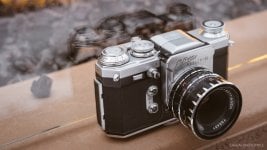
Vince Lupo
Untitled
Bingo Vince! I've been hunting for one of these. I think they are sweet looking cameras. And thanks for the thread Jason!
Check out this article:
https://casualphotophile.com/2019/02...dixa-reflex-b/
(pic courtesy of the article)
There’s a few on eBay right now, though most of them have the eye-level prism.
Erik van Straten
Mentor
I think it's great that Nikon was able to beautifully design not only the flagship Nikon F, but also all the additional lenses and other dedicated equipment. Everything was very nicely brought together in terms of design. In my opinion, the Nikon F system was the first camera system designed in that way.
Erik.
Erik.
p.giannakis
Pan Giannakis
The Most Beautiful Cameras of All Time, Part 2
Manual focus 35mm film SLRs of the ‘50s through the ‘80s
All these members of what Pentaxians refer to as the “S-family” of Pentax screw-mount cameras released prior to the landmark Pentax Spotmatic of 1964 are exquisitely proportioned, superbly balanced cameras, with gorgeously contoured wind levers and any of them, including the H2, are among the most beautiful SLRs ever made. They’re also great user collectibles, and you can snag a clean working Asahi Pentax H2 with semi-auto 55mm f/2 Takumar lens for around $150.
[/FONT]
Asahi Pentax H2 with 55mm f/2 Auto-Takumar semi-auto-diaphragm lens: It's clean crisp lines and straightforward balanced proportions make it a classic.
A few years back Roger Hicks posted a picture on RFF of his old black Pentax SV and it was one of the most beautiful cameras I've ever seen. Unfortunately the dead link has been removed. He also had an old battered Black Spotmatic that made me go and buy one too. Beautiful cameras.
I think the early Minolta SR series (not the later SRTs) make a strong case for prettiest Japanese SLR.
As demonstrated to great effect by Pan in the 'Show us your SLR' thread...
I think the black early SR1 I have is beautiful. I used it last weekend. Now I ordered a black Spotmatic II, I will post a pic when I receive it (I need a Takumar now too).
Rick Waldroup
Well-known
The removable hot shoe messed up the lines of the OM-1, which is beautiful without it.
Not a fan of the T-90 looks although a great camera.
What about the Porsche Designed Contax RTS? Or several of the other Contax models, particularly the 139 Quartz.
Ugliest? Leica R8/R9.
I agree about the Contax RTS. I owned one of these, the first version, and it truly was a beautiful camera.
nickthetasmaniac
Mentor
A few years back Roger Hicks posted a picture on RFF of his old black Pentax SV and it was one of the most beautiful cameras I've ever seen. Unfortunately the dead link has been removed. He also had an old battered Black Spotmatic that made me go and buy one too. Beautiful cameras.
I remember that photo, I think it was what prompted my search for a black SV.
This is my chrome and black pair, alongside Gerjan's updated screwmount guide. The black SV (or any black S-series really) is indeed a lovely camera.

And the black body shot with an Autocord.

DownUnder
Nikon Nomad
Let's not overlook or forget the Nikkormat, the humble 'little brother' of the Nikon F, elegant in its own way and 95% as useful as the professional Fs of the 1960s. Not quite as adaptable as the F, but with just as good metering (surprisingly accurate for its time), the 'mats were the preferred second camera of almost every pro back then, and many are still available at reasonable cost in the used camera markets, as good as new and as sturdy as Sherman tanks.
In my time I've used FTs, FTNs, ELs and FT2s - I still have two of the latter, and I take them out fairly regularly on country rambles and bush treks, to exercise the shutters as well as the shooter. One has a 35/2.0 permanently affixed to it and the other sports either a 28/3.5, a 55/3.5 micro Nikkor or on those rare occasions when I want a longer lens, an 85/2.0.
For me, the perfect kit. And affordable.
In my time I've used FTs, FTNs, ELs and FT2s - I still have two of the latter, and I take them out fairly regularly on country rambles and bush treks, to exercise the shutters as well as the shooter. One has a 35/2.0 permanently affixed to it and the other sports either a 28/3.5, a 55/3.5 micro Nikkor or on those rare occasions when I want a longer lens, an 85/2.0.
For me, the perfect kit. And affordable.
santino
FSU gear head
I‘d add the original Zenit (1). It‘s the SLR Leica never built and has a classic Leica-esque design.
Share:
-
This site uses cookies to help personalise content, tailor your experience and to keep you logged in if you register.
By continuing to use this site, you are consenting to our use of cookies.


